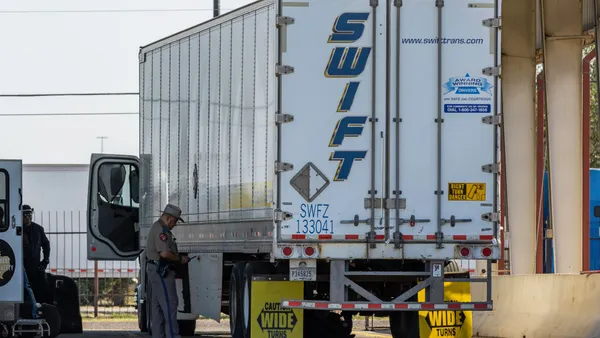Dive Brief:
- Employment in local general freight transport has rebounded to 2019 levels, but employment has remained fairly flat in long-distance general freight transport, said Jason Miller, associate professor of logistics at Michigan State University, citing data from the Bureau of Labor Statistics.
- Truck transportation overall added 7,300 jobs in December, according to seasonally adjusted figures. Not seasonally adjusted numbers, however, showed a loss of 2,500 jobs. "Seasonally adjusted statistics, while informative, you have to take with a grain of salt, because seasonal adjustment is based off of past behavior," Miller said.
- Miller expects employment to rise more slowly going forward, in part because training schools have churned out fewer drivers due to COVID-19 restrictions. Tempered employment growth, combined with continued freight demand and retail restocking, will keep spot prices elevated, Miller predicted.
Local freight employment rebounds to 2019 levels
Dive Insight:
BLS' latest statistics indicate that the driver workforce likely prefers short, local hauls over long-distance ones, especially in the time of the coronavirus.
"You have long-haul drivers who say, 'You know what, I don't want to risk getting COVID. I don't want to be on the road for two weeks. I'd rather be working closer to home and be home every night,'" Miller said.
Home time was drivers' top concern during a Q3 2020 feedback survey conducted by WorkHound.
It's possible that drivers furloughed or laid off during the early days of the pandemic went to work for specialized or local carriers. Employment in the specialized local freight sector typically drops from October to November, but the figures stayed flat during that period in 2020. Specialized sectors include intermodal drayage, gasoline shipping and transport needed for construction firms, such as material haulage for lumber yards, Miller said.
LTL long-distance freight employment lags behind 2019
National TL and LTL fleets will have to consider driver preferences for short hauls, if they want to recruit and retain their workers.
Max Farrell, co-founder and CEO of WorkHound, said he has observed fleets creating more regional routes.
"Motor carriers are redesigning how they’re distributing work so that drivers can have consistent miles, but also have the ability to be home in bed every night," he said in December.
Employment patterns unsurprisingly deviated from the norm in the BLS' truck transportation category. "When you have a major shock like COVID ... you're not going to have activity returning to the 'normal' behavioral patterns," Miller said.
Usually employment numbers drop off from November to December as peak season freight tapers. From November 2019 to December 2019, figures not seasonally adjusted dropped 14,500. And the same period in 2018 saw a loss of 5,200 jobs.
But a surge in imports at West Coast ports correlated with a drop of just 2,500 truck transportation jobs from November to December in 2020. Ocean carriers and analysts anticipate port congestion could last into February or March as imports keep arriving to California's shores, and fleets that serve the region will need drivers to keep loads flowing.












